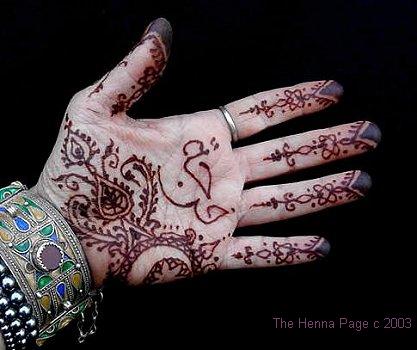 |
 |
 These are Catherine Cartwright-Jones's best "terped" henna mixes, developed at the 2001 Serious Henna Conference. Each will stain the skin within minutes! Paste left on as little as 15 minutes will darken into a hazelnut-shell colored stain even on an upper arm. Paste left on for an hour will darken to chestnut-husk color on the leg or inner wrist. It is not necessary to leave the paste on for longer than 3 hours! Navel henna, left on only an hour, can darken to brazil-nut shell color. Palms and fingers stains darkened to burgundy/black within 48 hours of paste removal, with neither seal nor wrap! Very little, if any, improvement in stain is gained from prolonged application with these mixes. A teaspoon of sugar seems to be a useful addition to all these mixes. The "water-drawing" characteristic of sugar keeps the paste moist, and holds the paste on the skin. Sugared mixes seemed to be darker in comparison to non-sugared mixes. However, in very humid weather, sugary pastes can become uncontrollably slimy. Prepare your paste by mixing lemon juice into good quality henna powder, until the paste is as thick as mashed potatoes. Leave that to brew overnight. Add more lemon juice and a bit of sugar to get the texture the way you like it. Next morning add your essential oils. Wait at least one hour after adding the oils before you use the paste. The chemical reaction needs time to happen. The paste will still give superb results at 24 and 48 hours after mixing. All these mixes were tested at about 80F, 26 C. These mixes work far better on HOT days! These measurements are very approximate, and you may need more or less of the "terps" depending on their strength! If you don't get the results you want with small proportions, you may need to add more of your "terps", or you may need to let the mix sit a little longer. Use anything from 2 to 8 drops of "terps" per 20 g of powder. There's no way to be certain how much you'll need because every henna and every distillation of essential oil is different. More "terp" generally gets you darker stain. Too much "terp" can be fragrant enough to give you a headache (and your clients, too), or cause skin irritation. "Terp" wisely and well! Use these mixes FREELY
when making
your own paste ... Tea Tree Essential Oil and Geranium Bourbon Essential Oil Tea Tree and Geranium Bourbon (Rose Geranium): lovely, earthy summer rose garden scent that permeates your henna room and clings to your skin! Tea Tree , Cardamom and Neroli Tea Tree, Cardamom and Neroli: sexy, spicy, manly scented henna, that stains dark hazelnut shell color on shoulders! Tea Tree, Neroli and Clove Bud Tea Tree, Neroli, and Clove Bud: manly, spicy and sexy, but don't use it on tender skin. Clove can be harsh! Tea tree, Cedar, Juniper and Lavender Tea Tree, Cedar, Juniper and Lavender: high mountains, clear air, cool forest smell. Cajeput and Cypress Tips Cajeput and Cypress Tips: clean, resinous, woodsy scent. Rosemary can be added to soften the scent. Cajeput, Geranium and Thyme Cajeput, Geranium and Thyme: earthy, summery, sexy female scent. Cajeput and Geranium Bourbon Cajeput and Geranium Bourbon: heavenly scent... very womanly! Cajeput, Cardamom and Frankincense Cajeput, Cardamom and Frankincense: the scent is intoxicating and sensuous. Ravensara and Geranium Ravensara and Geranium: an earthy, floral summer garden.. Lavender Lavender essential oil added to
paste darkens
the henna stain, and is the least likely to cause a skin reaction of
all
the essential oils. If you henna children, or pregnant women,
lavender
is your safest terp! All
text and
images on this page
copyright 2003 all rights reserved Catherine Cartwright-Jones The Henna Page Can't find what you want here? Try The Henna Page Main Index. |